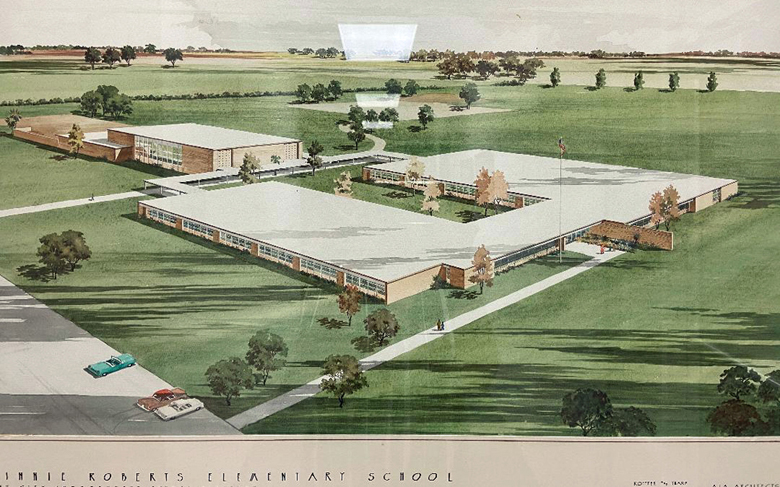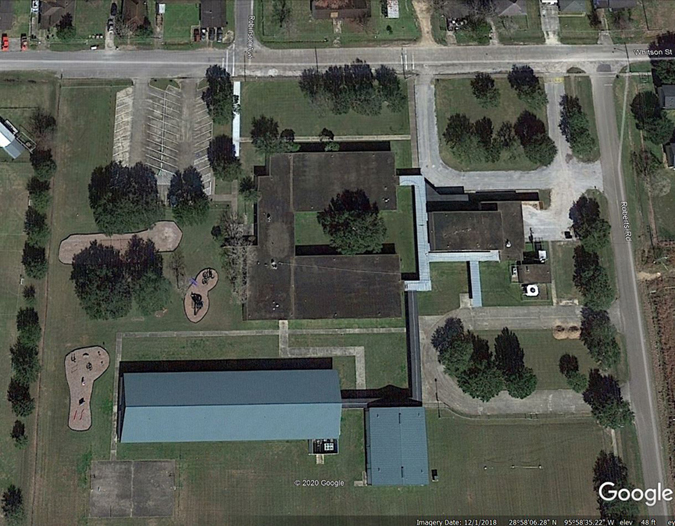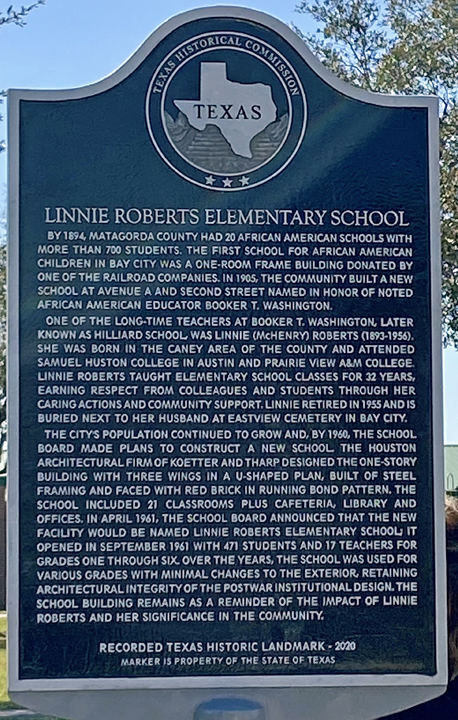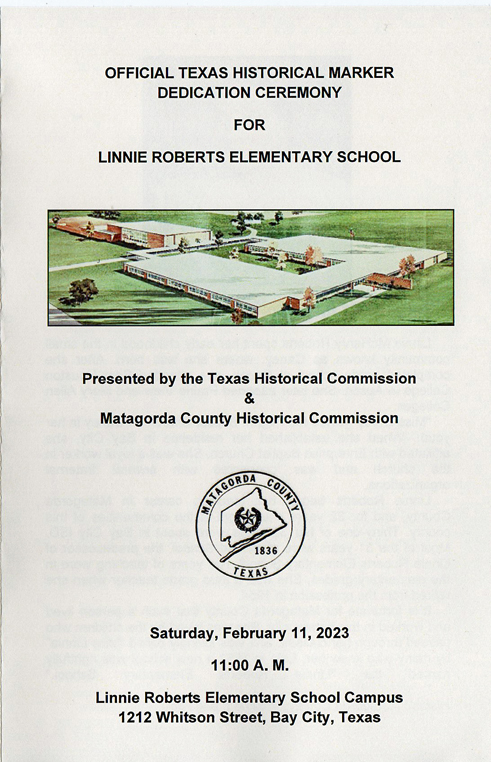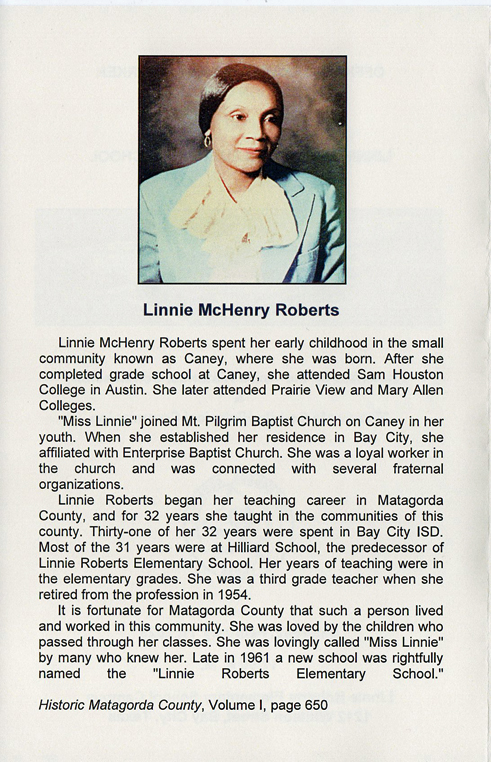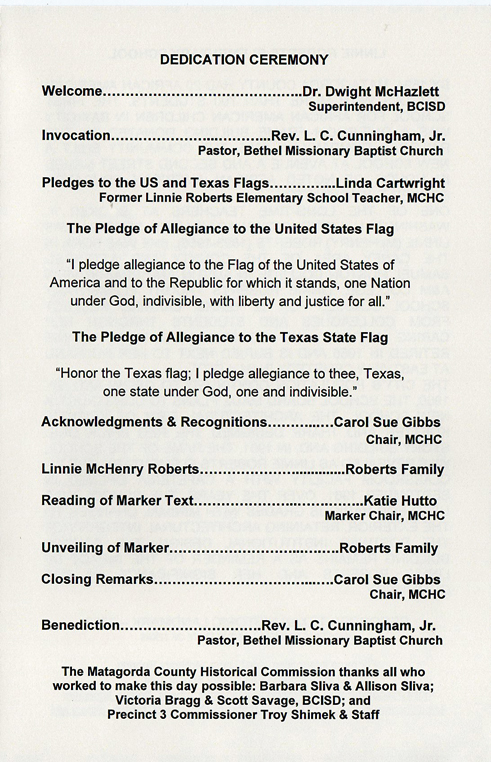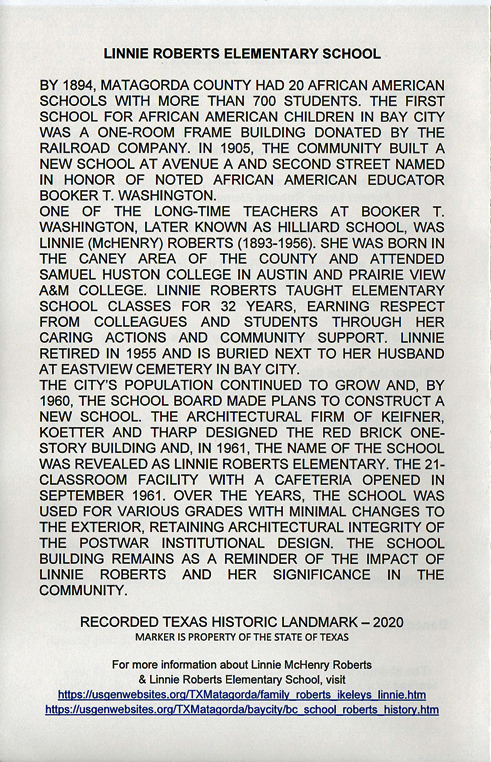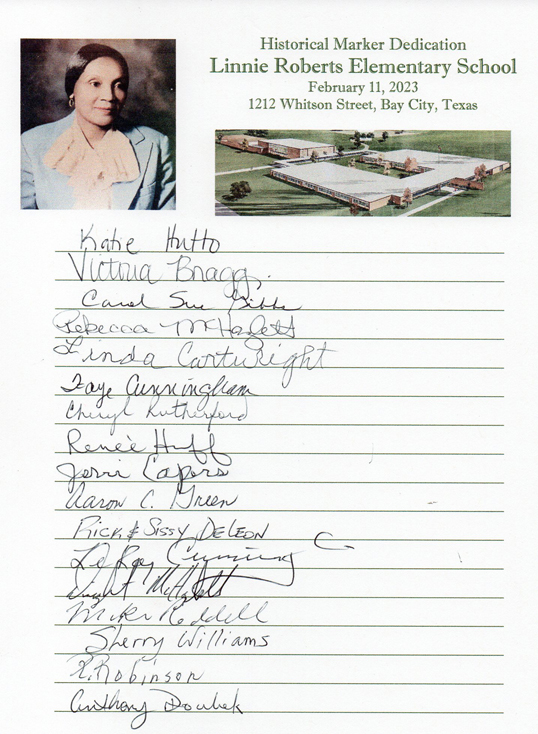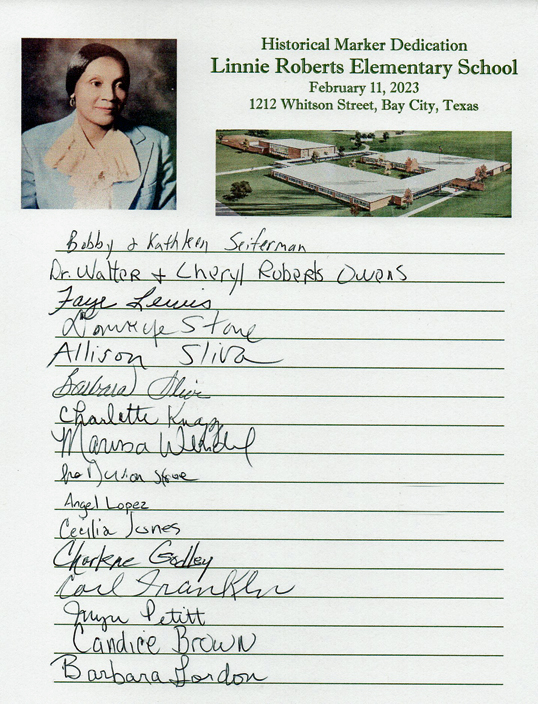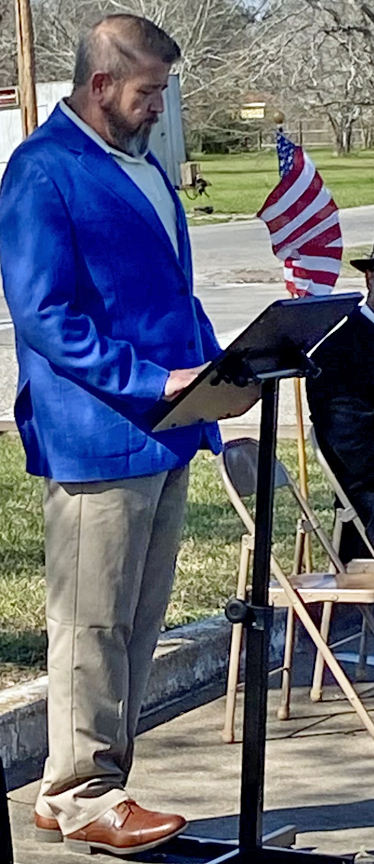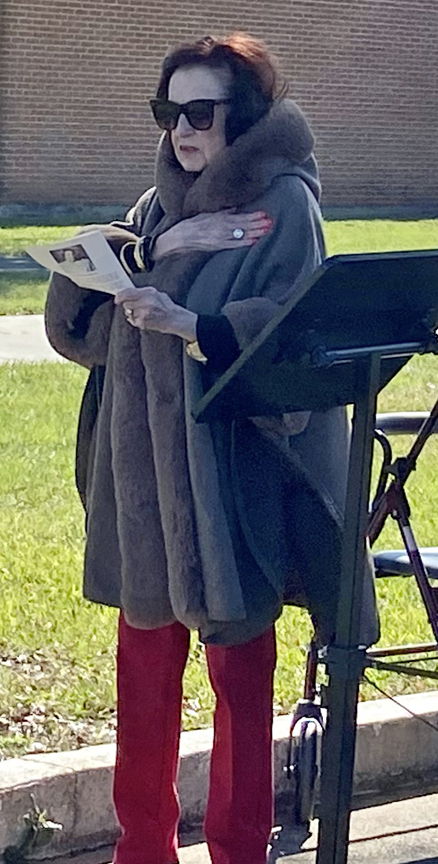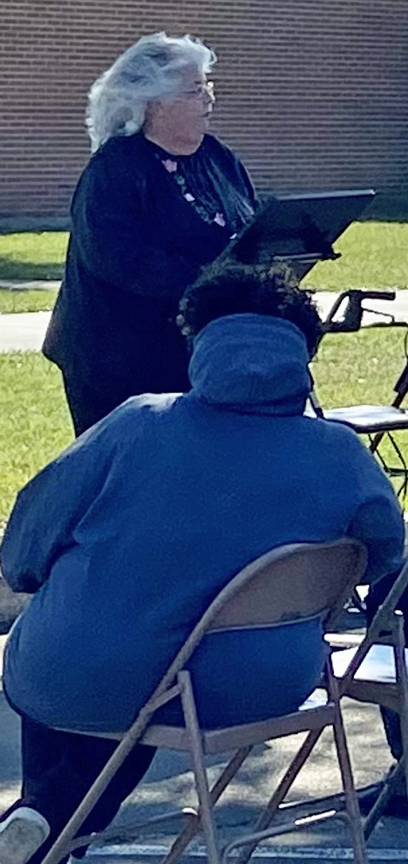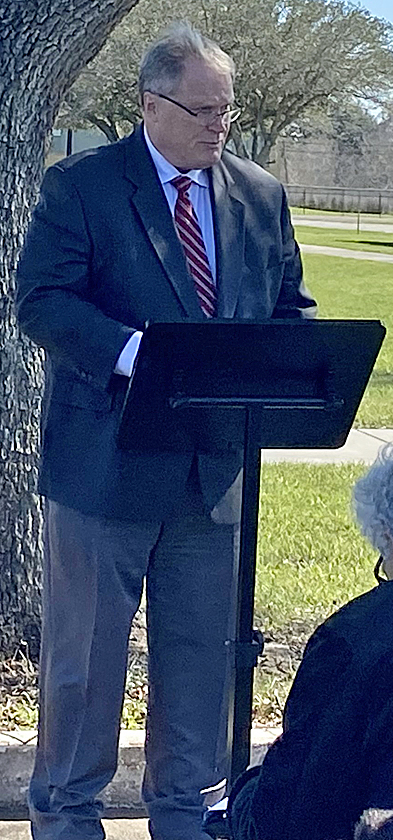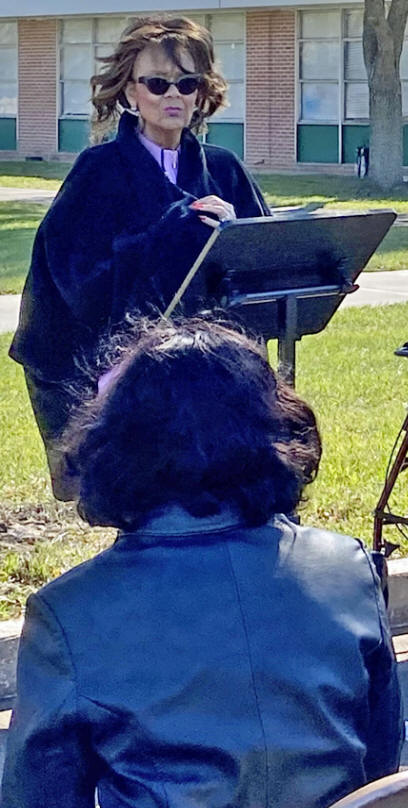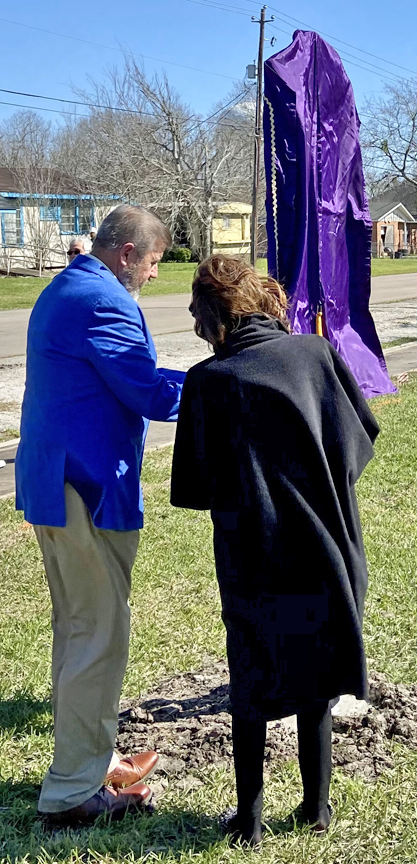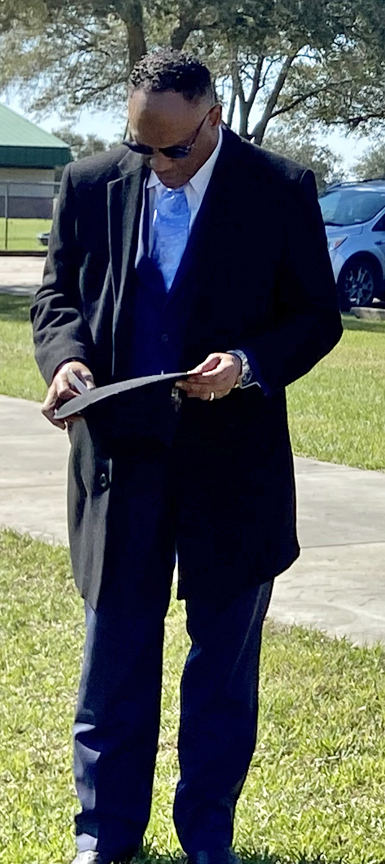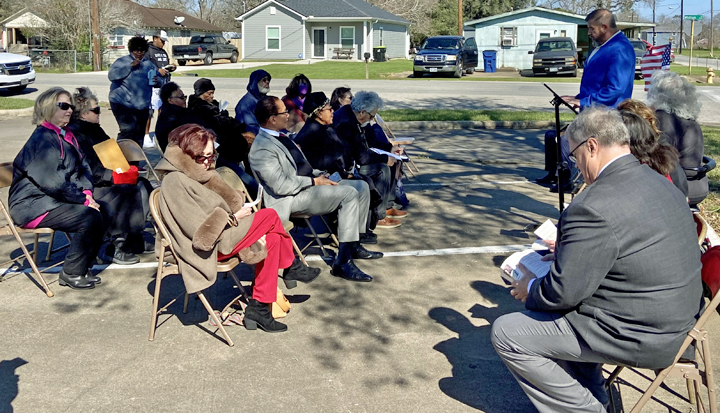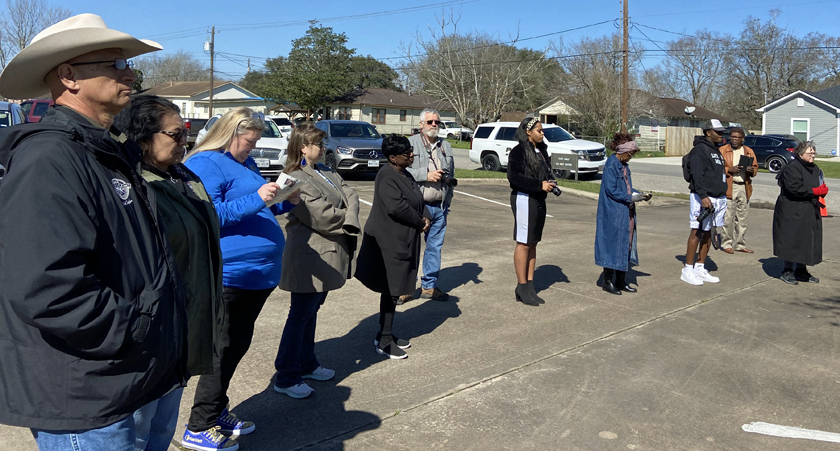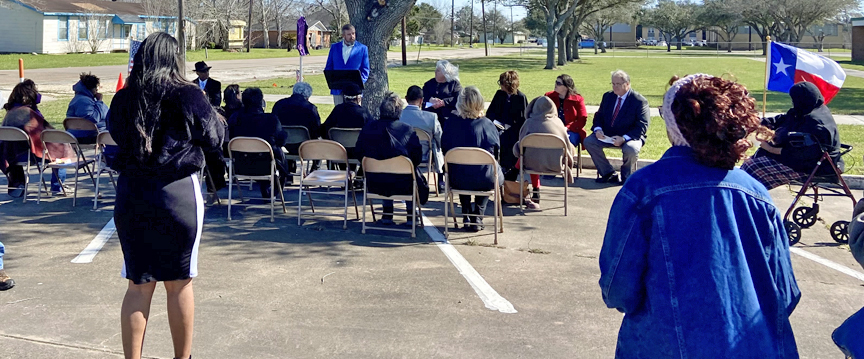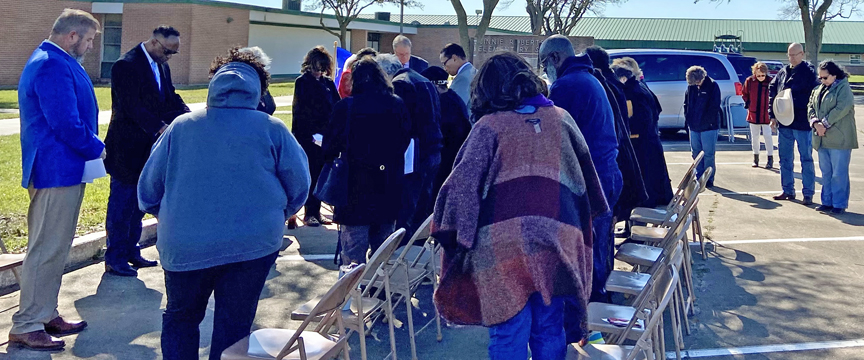|
Linnie McHenry Roberts Linnie Roberts Elementary School Photos 2016
Linnie Roberts Elementary School Historical Marker Dedication |
|
|
|
Education for African American children before the Civil War was sporadic at best, depending on whether the slave owner allowed the education of the children or whether a literate slave was able to teach the children to read. Many southern states prohibited education of slaves, but Texas did not. With the illiteracy rate of 95%, it was evident that most slave owners did not allow the practice. The Texas Constitution of 1876 stipulated that impartial provisions for each race was necessary, but separated. By 1894, Matagorda County had 20 African American schools with 783 students enrolled. Most were small country schools, often meeting in the church building for the community. The only exception was the school in the town of Matagorda. The 1895 census enumerated 19 schools with 733 students. Bay City had been founded in 1894 and the Bay City students were enumerated for the first time, a total of two. The August 27, 1896 issue of the Bay City Breeze announced that the African American people of Bay City organized a pretty good sized school. The first school for African American children in Bay City was located in the 1100 Block of Avenue A and Second Street. This school was a small one-room frame building donated by the railroad company. The first African American teacher in Bay City was Algeron Alfonso DeLeon (1860-1934). As the school population grew, new teachers were hired. In May 1897, a “Colored” teachers institute was formed and A. G. Hilliard I (1863-1931) was elected president. II. OVERVIEW Linnie McHenry was born July 10, 1893 in the Caney area of Matagorda County, the daughter of Hale Foster McHenry (1870-1942) and Dinah Wiley McHenry (1882-1935). The McHenrys were married in 1895 and were pioneer landowners in Matagorda County, Texas. There were three children in the McHenry family: Clem McHenry (1891-1965), Linnie McHenry Roberts and Mary Ella Roberts Duncan (1898-1981). Linnie McHenry’s life was inspired by the domestic virtues of her industrious mother, and the leadership qualities of her successful father. His occupation as a farmer, carpenter, blacksmith, shoemaker and barber accelerated his ambition to educate his children. He realized the importance of academic achievement for African American children. Linnie’s first church membership was at Mt. Pilgrim Missionary Baptist Church located on Caney Creek. The church also served as a school for the local African American children. After completing her early education in Matagorda County, she attended Samuel Huston College in Austin and Prairie View A & M College in Prairie View. She completed her college work at Mary Allen College in Crockett. Linnie’s sister, Mary Ella McHenry Duncan was also a teacher and noted educator in Matagorda County. Linnie married Ikleys Roberts (1888-1977) on December 16, 1917 Mr. Roberts was the first licensed mortician in Matagorda County. They had three children: Christine Roberts Covington (1918-1989) and Theresa Roberts Lewis (1920-1999) who became teachers and Eddie, (1922-2020) who joined his father in the funeral business. Linnie Roberts taught for 32 years. She taught elementary grades for 31 years in Bay City at Booker T. Washington which later became Hilliard School. At the time of her retirement she was teaching third grade. “Miss Linnie,” as she was known, participated in the Colored Teachers’ Institute on September 26, 1930 demonstrating her recognition of the benefit of networking with other county teachers. “Miss Linnie” was a model of neatness and order in appearance and classroom practices. She was also a very punctual person. She not only concerned herself with the education of her students. She saw to their general well-being by purchasing books, providing lunch and even mending their garments and replacing missing buttons. “Miss Linnie” would take extra food to school and heat it on the wood burning stove for students who lived too far away to walk home for lunch. She would stop on her way to school and pick up students who had to walk to school when it was cold or stormy. Her giving spirit extended to the community and her church home at Enterprise Baptist Church in Bay City. She retired in 1955 and died on December 6, 1956. She and her husband were buried at Eastview Cemetery in Bay City. Bay City’s school population continued to grow and by the time Linnie Roberts retired, more teachers were needed. The African American school, which housed all grades, was named Booker T. Washington and later Hilliard School. By 1959, the school was no longer adequate for the African American students and the school board began to make plans to alleviate the overcrowding problem.
On December 15, 1959, the New Building Committee
of the Bay City ISD requested a special meeting of the board of
trustees to discuss the need for more educational space for African
American students. Options included adding classrooms to the
existing Hilliard School, After viewing buildings by two architectural firms, the BCISD board chose Keifner, Koetter and Tharp as the architects for the future project. On July 19, 1960, the BCISD board accepted the recommendation that a bond issue in the amount of $1,200,000, along with Senate Bill 116, be submitted to voters in September, 1960. Senate Bill 116 permitted school districts to raise the tax rate. Many school districts were up to their tax rate limits under the old law and the only alternative was to re-value properties. Under Bill 116, bonds could be obtained at a lower rate of interest which would eventually create savings for the taxpayers. Taxpayers overwhelmingly approved the bond issue of the amount approved, approximately $462,240 for a new junior high, $371,440 for a new Hilliard Elementary, $50,000 to purchase building sites, $56,338 for contingencies. The projected enrollment was 4,173 students for the district. The votes were canvassed by the Board at a special meeting on October 6, 1960. The proposition to levy and collect tax passed 665–103 and proposition to issue bonds passed 672-94. The election provided for the construction of the Hilliard Elementary school which would be scheduled to open in September 1961 and a junior high school in January, 1962. On January 17, 1961, architects Gunter William Koetter (1919-1996) and Charles Harold Keifner (1896-1976) presented plans for the new elementary and the materials required. Final plans went out to bidders on February 7, 1961, with bids due in tentatively on March 2, 1961 at 7:30. The Board accepted the low bid for bonds from The First National Bank of Dallas on February 2, 1961. The average interest rate would be 3.52141%, with $525,175 being the total interest to be paid. The bid from D. W. Marshall Construction Company for $302,005 was accepted on March 2, 1961 upon approval from the architect. After consulting the architects, the bid accepted on March 2nd was rescinded. The architect was instructed to readjust the wage scale to the prevailing local wage and requested the two low bidders to resubmit bids. D. W. Marshall Construction Company or Victoria, Texas, resubmitted their original bid and it was accepted for a second time at a special meeting on March 8, 1961. The board accepted materials for the Hilliard Elementary as recommended by the architect: ceiling tile for foyer, halls and classrooms, tile for wainscoting, and materials for outside underneath the windows. The purchase of furniture for Hilliard Elementary was discussed and H. J. McAllister (1909-1963) and Business Manager Bernard E. Liston (1905-1993) were to proceed taking bids. The architect did not recommend treating soil at Hilliard Elementary for termites as the entire structure was masonry and steel. The name of the new elementary school was discussed and three letters suggesting three names were read to the board. The Superintendent was instructed to let the faculty of Hilliard School decide on one of the three names. The April 20, 1961 issue of the Daily Tribune reported “New Elementary School is Named; Principal Selected.” The Board of Trustees announced the selection of a name and principal for the new elementary school. It has been named the Linnie Roberts Elementary in honor of a former teacher in the system. The new principal will be Dave Young, a veteran of more than 20 years in the Bay City System. The Trustees chose to honor the late Mrs. Roberts after ‘careful and long consideration.’ Superintendent McAllister stated ‘Mrs. Roberts name was proposed by the Colored Ministerial Alliance and teachers at Hilliard School from several candidates mentioned. Mrs. Roberts was a model of neatness and order in appearance and in classroom practices. She was very punctual, participated in school concessions, was a church and choir member and coached sub junior spelling in local Interscholastic League meets.’” The Board approved the red brick and green colors for Linnie Roberts School as presented by the architect. The cost of the name plate for Linnie Roberts Elementary School was more than was allowed in the contract, but the Roberts family agreed to make up the difference. Upon motion by Trustee Alma Mehrens (1912-2005), seconded by Trustee U. U. “Dean” Smith (1914-1968, and passed, the Board accepted the four new rooms at Pierce and the Linnie Roberts School, subject to the punch list. The new facility, located at 1212 Whitson Street, was opened for the first time with the beginning of classes in September, 1961. The enrollment, at the 21 classroom brick contemporary construction, was 471 and 17 teachers were staffing the six grades of the new school. The new building incorporated a modern cafetorium and a library in addition to the classroom space. Principal Dave Young announced on October 12, 1961 the formal dedication services would be held at the Linnie Robert Elementary School at 3:00 p. m., Sunday, November 5th, 1961. The Roberts Glee Club participated in the dedication. The Linnie Roberts Elementary School faced west and was masonry and steel. The contemporary red brick construction was like many post-war schools which were more standardized and cost-conscious. It was one-story with a flat roof like the Bay City Junior High School which opened in 1962. The building was in a U-shape with the office and library in the north to south portion. The two wings of classrooms had inside corridors. The wings ran east-west and had northern-southern exposure which allowed all classrooms maximum access to fresh air and daylight. The upper portion of the outside walls of the classrooms was composed of windows. The secretary the first year was Mary N. Love and the faculty included the following teachers; first grade, E. J. Odem, Melissa Amey and Pinkie Juanita Wright; second grade, Joe Ann Davis, Joyce E. Jones and Hilda B. Francis; third grade, Thelma M. Woolridge and Barbara J. Caesar; fourth grade, Naomi B. Young, Rose M. Castilow and Nina. M. McGaffey; fifth grade, Albennie Thomas and Ethelyn H. White; sixth grade, Otis Fisher, Jr. and Doris R. Preston; and special education, Olivia Rhambo. The first Parent Teachers Association included F. Earls, chairman and public relations; Dave Young, principal; G. Spiller, secretary; W. Robinson, president; N. Brown, 1st vice president; S. Price, 2nd vice president; W. Taylor, treasurer; Rose Castilow, parliamentarian; Melissa Amey, membership committee chairman; A. Thomas, program committee chairman; and R. Flye, budget and finance committee chairman. The grade configuration for Linnie Roberts Elementary School has changed as needed to accommodate students of Bay City ISD. Those being: 1961-68 Grades 1-6; 1969-2000 Grades 2-5; 2001-02 Grades 1-5; 2002-2003 Grades 1-3; 2003-2011 Grades PK-3; 2011-2020 Grades 1-2. The appearance of the building has changed little during the 60 years of use. The school was originally unair-conditioned, and when air conditioning was installed, window upgrading was necessary to make the rooms more energy efficient. The library, which is on the front of the school, needed more room for shelving. The windows were covered outside with hardy plank so there would be a solid wall inside and much needed wall shelving could be installed. The hardy plank can be removed to return to the original look. The additional 14-room classroom wing and outside gym were first used the 2011-12 school year. III. HISTORICAL SIGNIFICANCE Linnie Roberts Elementary School was the first and only elementary school dedicated to the education of African American children. After integration it continued as an elementary school with a different ethnic population. Mrs. Roberts was a giant of a personality. She was the epitome of an educator, a wife, and a mother. Her humanitarian deeds were not only exhibited with the students she taught, but her giving spirit reached deep within the community in which she lived. She always wore a smile, and always had that encouraging word to offer anyone who crossed her path. To those co-educators who started in the teaching profession early, she was their mentor. She left a legacy to those students whose lives she touched. She also left a legacy to her family, children and grandchildren. Today the Linnie Roberts Elementary School continues to stand as a monument to her legacy. The new building will continue to honor her.
Presently, in June, 2020, the Linnie Roberts
Elementary School campus is comprised of the original building and
cafetorium with an additional 14 classroom wing, and an outdoor
gymnasium. After a realignment of grades in Bay City ISD in 2019-20,
Linnie Roberts was designated to house first and second grades. It
will be used only one more year as construction has begun for a new
Linnie Roberts Elementary School which will open in the fall of
2021. The original building will be preserved and plans are being
considered to use it as a community center. |
|
|
|
||||||||||||||||
|
||||||||||||||||
|
||||||||||||||||
|
||||||||||||||||
